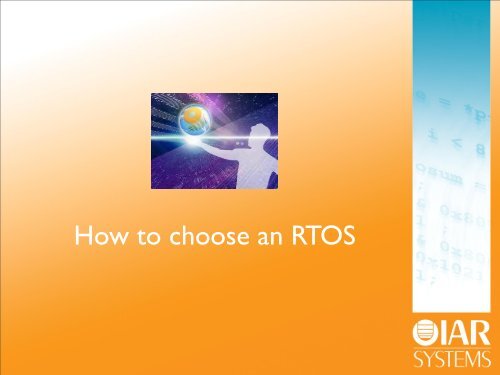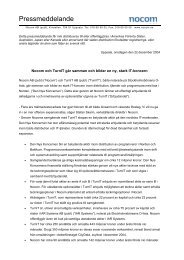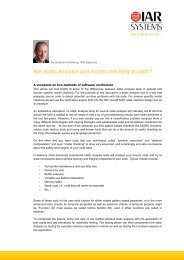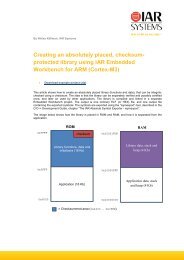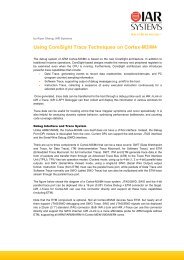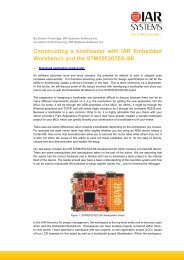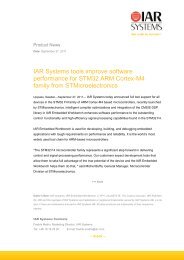Choosing an RTOS - IAR Systems
Choosing an RTOS - IAR Systems
Choosing an RTOS - IAR Systems
Create successful ePaper yourself
Turn your PDF publications into a flip-book with our unique Google optimized e-Paper software.
How to choose <strong>an</strong> <strong>RTOS</strong> – ESC 2011<br />
How to choose <strong>an</strong> <strong>RTOS</strong>
How to choose <strong>an</strong> <strong>RTOS</strong> – ESC 2011<br />
Agenda<br />
•What is <strong>an</strong> <strong>RTOS</strong>?<br />
•Definition<br />
•Free vs. Commercial <strong>RTOS</strong>s<br />
•Benefits of using <strong>an</strong> <strong>RTOS</strong><br />
•Safety<br />
•Reliability<br />
•Rapid development<br />
•What should I look for in <strong>an</strong> <strong>RTOS</strong>?<br />
•Common elements of <strong>RTOS</strong>s<br />
•Example of <strong>an</strong> <strong>RTOS</strong> in action<br />
•Webserver<br />
•USB Device
How to choose <strong>an</strong> <strong>RTOS</strong> – ESC 2011<br />
What is <strong>an</strong> <strong>RTOS</strong>?<br />
• An <strong>RTOS</strong> is <strong>an</strong> operating system designed to<br />
service the needs of <strong>an</strong> embedded system in realtime.<br />
• It gives you the ability to access peripherals on<br />
the device in a m<strong>an</strong>ner similar to the way that you<br />
access files in desktop C<br />
• It helps you keep processes in your application<br />
from interfering with one <strong>an</strong>other by placing them<br />
in tasks<br />
• It gives you modularity to add plug-ins such as a<br />
USB Host Stack or a TCP/IP Stack<br />
• It controls inter-task communication through the<br />
use of messages <strong>an</strong>d queues<br />
• It c<strong>an</strong> use semaphores to ensure that only one<br />
task at a time uses a certain peripheral<br />
• It assigns priorities to tasks according to their<br />
import<strong>an</strong>ce in the application <strong>an</strong>d switches<br />
between them using a scheduling algorithm
How to choose <strong>an</strong> <strong>RTOS</strong> – ESC 2011<br />
Free vs. Commercial <strong>RTOS</strong>s<br />
•A free <strong>RTOS</strong> offers a cost-effective solution to m<strong>an</strong>age your code<br />
with the benefits previously mentioned:<br />
•No cost for the <strong>RTOS</strong><br />
•No royalties for products made using the <strong>RTOS</strong><br />
•Easy to try out in your design<br />
•However, free <strong>RTOS</strong>s have some drawbacks:<br />
•Not as well-supported as commercial <strong>RTOS</strong>s<br />
•Generally not as well-optimized as commercial <strong>RTOS</strong>s<br />
•Generally do not have as m<strong>an</strong>y plug-ins or bolt-ons as<br />
commercial <strong>RTOS</strong>s
How to choose <strong>an</strong> <strong>RTOS</strong> – ESC 2011<br />
Benefits of using <strong>an</strong> <strong>RTOS</strong><br />
• Scheduling algorithms – although easy to comprehend – are<br />
amazingly difficult to write:<br />
• Latent defects in context switching from one task to <strong>an</strong>other<br />
• Minimizing context switch latency<br />
• Priority inversion issues<br />
• Using <strong>an</strong> <strong>RTOS</strong> allows you to increase the safety of your code<br />
by ensuring that code c<strong>an</strong> execute in deterministic time or meet<br />
a certain deadline<br />
• Using <strong>an</strong> <strong>RTOS</strong> increases the reliability of your code by<br />
encapsulating the individual tasks in such a way that they do<br />
not interfere with one <strong>an</strong>other<br />
• By allowing the <strong>RTOS</strong> to do your scheduling <strong>an</strong>d priority, you<br />
simplify the application code that you have to write <strong>an</strong>d speed<br />
your time-to-market
How to choose <strong>an</strong> <strong>RTOS</strong> – ESC 2011<br />
What to look for in <strong>an</strong> <strong>RTOS</strong><br />
• Determinism – does the <strong>RTOS</strong> have published numbers on<br />
the minimum, average <strong>an</strong>d maximum cycles its functions<br />
require?<br />
• Interrupt latency – how long does it take between the time<br />
the interrupt is received by the MCU <strong>an</strong>d the time the<br />
Interrupt Service Routine (ISR) begins executing?<br />
• Context switch time – how long does it take the <strong>RTOS</strong> to<br />
switch between the different tasks in the task pool?<br />
• Available plug-ins – USB Host, USB Device, TCP/IP,<br />
Bluetooth, SSH, SSL, etc.<br />
• Compatibility of <strong>RTOS</strong> with your chosen toolchain<br />
• Overall cost of <strong>RTOS</strong> – initial cost, procuring source code of<br />
<strong>RTOS</strong>, support costs, royalties, mainten<strong>an</strong>ce costs<br />
It should be relatively easy to compare these features from one<br />
<strong>RTOS</strong> to <strong>an</strong>other once you have a target <strong>an</strong>d feature set<br />
decided.
How to choose <strong>an</strong> <strong>RTOS</strong> – ESC 2011<br />
Common features of <strong>RTOS</strong>s<br />
Memory allocation<br />
• Usually, most objects are inst<strong>an</strong>tiated at run-time, so <strong>an</strong><br />
<strong>RTOS</strong> needs the ability to dynamically allocate memory.<br />
• The st<strong>an</strong>dard C function malloc is not thread-safe, so the<br />
<strong>RTOS</strong> must provide a thread-safe method to replace it.<br />
• Different <strong>RTOS</strong>s do this in different ways, so if your<br />
application does quite a bit of dynamic allocation <strong>an</strong>d<br />
recollection of memory, this c<strong>an</strong> have a deleterious impact<br />
on your code.<br />
• In general, higher-end commercial <strong>RTOS</strong>s do the best job of<br />
memory allocation<br />
• Be sure to use the thread-safe memory functions provided<br />
to you by the <strong>RTOS</strong>!
How to choose <strong>an</strong> <strong>RTOS</strong> – ESC 2011<br />
Common features of <strong>RTOS</strong>s<br />
Tasks<br />
• All <strong>RTOS</strong>s allow you to perform functionality within a task<br />
• It is sometimes difficult to tell if two tasks should be<br />
combined into one or vice-versa, similar to deciding whether<br />
two functions should be combined into one or vice-versa<br />
• A task has a control block which is a piece of RAM that<br />
contains the task’s stack <strong>an</strong>d other import<strong>an</strong>t information<br />
that is written to whenever the task is “switched out” for<br />
<strong>an</strong>other task. Similarly, that information is loaded back<br />
when the task is “switched in”, so the state of each task is<br />
saved in the block.<br />
• Different <strong>RTOS</strong>s have different limitations on the number of<br />
tasks that c<strong>an</strong> be created <strong>an</strong>d on the number of different<br />
priorities that c<strong>an</strong> be assigned to the tasks. A typical <strong>RTOS</strong><br />
application uses 10-15 tasks.
How to choose <strong>an</strong> <strong>RTOS</strong> – ESC 2011<br />
Common features of <strong>RTOS</strong>s<br />
Task schedulers<br />
• Different <strong>RTOS</strong>s use different scheduling algorithms<br />
• Co-operative schedulers require the tasks to yield( )<br />
in order to allow other tasks to execute.<br />
• Pre-emptive schedulers are more common in <strong>RTOS</strong>s<br />
<strong>an</strong>d may take several forms:<br />
• Round-robin scheduling, where each task gets a<br />
time-slice of the MCU<br />
• Fixed-priority pre-emptive, which ensures that the<br />
next task with the highest priority gets executed<br />
• Rate-monotonic scheduling, where the task with<br />
the shortest duration has the highest priority<br />
• And others…<br />
• Some schedulers are more susceptible to priority inversion<br />
th<strong>an</strong> others, so be aware of deadlocks!
How to choose <strong>an</strong> <strong>RTOS</strong> – ESC 2011<br />
Common features of <strong>RTOS</strong>s<br />
Queues/messages<br />
• These provide a thread-safe m<strong>an</strong>ner for inter-task<br />
communication so that you don’t have one task reading a<br />
piece of RAM while <strong>an</strong>other is writing to it<br />
• A message is a fixed-length queue <strong>an</strong>d therefore generally<br />
has less overhead associated with processing it<br />
• Different <strong>RTOS</strong>s place different restrictions on the size of<br />
queues as well as how m<strong>an</strong>y queues/messages c<strong>an</strong> be<br />
created<br />
• These messages are processed in a FIFO m<strong>an</strong>ner, so the<br />
first queue/message to arrive is the first to be processed<br />
• The <strong>RTOS</strong> h<strong>an</strong>dles the allocation <strong>an</strong>d de-allocation of the<br />
queue/message using the same thread-safe memory<br />
m<strong>an</strong>agement previously described, so the efficiency of the<br />
m<strong>an</strong>ager c<strong>an</strong> impact the perform<strong>an</strong>ce for copious queues
How to choose <strong>an</strong> <strong>RTOS</strong> – ESC 2011<br />
Common features of <strong>RTOS</strong>s<br />
Queues/messages<br />
An ISR c<strong>an</strong> only post to the Queue whereas a task allows you<br />
to create <strong>an</strong>d modify a queue
How to choose <strong>an</strong> <strong>RTOS</strong> – ESC 2011<br />
Common features of <strong>RTOS</strong>s<br />
Semaphores<br />
• A semaphore is a flag of sorts that allows things to happen:<br />
• It may block a task from executing until a condition is<br />
satisfied<br />
• It may block access to a resource like <strong>an</strong> I2C bus<br />
• A task waiting on a semaphore is said to pend until the<br />
semaphore allows it to continue.<br />
• Once the semaphore ch<strong>an</strong>ges, it signals the <strong>RTOS</strong> to<br />
convey the state ch<strong>an</strong>ge to all interested tasks which may<br />
cause a pending task to become active<br />
• Semaphores c<strong>an</strong> cause priority inversion where a lower<br />
priority task has locked access to a resource that a higher<br />
priority task needs – some <strong>RTOS</strong>s solve this by priority<br />
inherit<strong>an</strong>ce which temporarily ch<strong>an</strong>ges the priority of the low<br />
priority task to a higher priority so that it c<strong>an</strong> complete <strong>an</strong>d<br />
release the resource at which time it is reverted back to a<br />
low priority.
How to choose <strong>an</strong> <strong>RTOS</strong> – ESC 2011<br />
Common features of <strong>RTOS</strong>s<br />
Events/Flags<br />
• A semaphore is a simple flag that allows a piece of code to<br />
execute if a resource is available or a condition is true<br />
• In general, events/flags allow the developer to specify a<br />
series of conditions that c<strong>an</strong> halt the execution of a piece of<br />
code until all the conditions defined by the events/flags are<br />
true<br />
• These give a greater degree of flexibility to the developer,<br />
but exactly how these are implemented (<strong>an</strong>d how m<strong>an</strong>y c<strong>an</strong><br />
be specified) varies from <strong>RTOS</strong> to <strong>RTOS</strong>, so it is import<strong>an</strong>t<br />
to know a priori approximately how m<strong>an</strong>y blocks a task may<br />
need when you choose your <strong>RTOS</strong><br />
• Having a good kernel-aware debugger is key when trying to<br />
debug problems related to events/flags!
How to choose <strong>an</strong> <strong>RTOS</strong> – ESC 2011<br />
Common features of <strong>RTOS</strong>s<br />
Ticks/Timers<br />
• A tick is often referred to as the “heartbeat” of <strong>an</strong> <strong>RTOS</strong><br />
• It wakes up the kernel <strong>an</strong>d allows it to switch from one task<br />
to <strong>an</strong>other<br />
• A task completion between ticks c<strong>an</strong> also cause a task<br />
switch<br />
• The tick must always run or the <strong>RTOS</strong> dies<br />
• The tick is usually set to around 500Hz-1kHz<br />
• If the tick is set too fast, the <strong>RTOS</strong> loses perform<strong>an</strong>ce<br />
because it spends all its time switching in the kernel<br />
• If the tick is set too slow, the <strong>RTOS</strong> loses perform<strong>an</strong>ce<br />
because it is too slow to respond to stimuli<br />
• Timers allow tasks to delay/wait for a finite period of<br />
specified time before the task continues execution<br />
• Timers c<strong>an</strong> also be used to allow tasks to run at set intervals
How to choose <strong>an</strong> <strong>RTOS</strong> – ESC 2011<br />
Common features of <strong>RTOS</strong>s<br />
Events/Flags<br />
(1) Hardware timer tick<br />
(2) Tick Interrupt Service Routine<br />
(3) OS Service to make tick task “ready”<br />
(4) The tick task
How to choose <strong>an</strong> <strong>RTOS</strong> – ESC 2011<br />
Common features of <strong>RTOS</strong>s<br />
Hook functions (a.k.a. callback functions)<br />
• A hook function allows a developer to attach a piece of code<br />
to a particular function within the <strong>RTOS</strong><br />
• These c<strong>an</strong> be h<strong>an</strong>dy if the <strong>RTOS</strong> source code is not<br />
available because it is proprietary or because it costs more<br />
money<br />
• These c<strong>an</strong> also be h<strong>an</strong>dy to ensure that you don’t actually<br />
touch the <strong>RTOS</strong> source <strong>an</strong>d inadvertently introduce a defect<br />
• Hook functions c<strong>an</strong> allow you to do pre- or post-processing<br />
of information in the <strong>RTOS</strong> without the overhead of a<br />
separate task creation<br />
• Common uses of a hook function include enh<strong>an</strong>cing<br />
debugging, key debouncing <strong>an</strong>d enh<strong>an</strong>cing functionality
How to choose <strong>an</strong> <strong>RTOS</strong> – ESC 2011<br />
Common features of <strong>RTOS</strong>s<br />
Hook functions (a.k.a. callback functions)<br />
For inst<strong>an</strong>ce, the debouncing of switch inputs may be more<br />
simply done by attaching a small piece of code to the periodic<br />
heartbeat function rather th<strong>an</strong> creating a separate task to<br />
perform this function.<br />
int debounce(int SampleA)<br />
{<br />
static int SampleB = 0;<br />
static int SampleC = 0;<br />
static int LastDebounceResult = 0;<br />
LastDebounceResult = LastDebounceResult &<br />
(SampleA | SampleB | SampleC) | (SampleA &<br />
SampleB & SampleC);<br />
SampleC = SampleB;<br />
SampleB = SampleA;<br />
return LastDebounceResult;<br />
}<br />
OSTimeTickHook()
How to choose <strong>an</strong> <strong>RTOS</strong> – ESC 2011<br />
Common features of <strong>RTOS</strong>s<br />
MMU <strong>an</strong>d MPU<br />
• Stack overflows are easily detected if the processor has a<br />
Memory M<strong>an</strong>agement Unit (MMU)<br />
• C<strong>an</strong> be configured to detect when a task attempts to access<br />
invalid memory locations<br />
• The MMU normally tr<strong>an</strong>slates virtual page numbers to<br />
physical page numbers via <strong>an</strong> associative cache called a<br />
Tr<strong>an</strong>slation Lookaside Buffer (TLB)
How to choose <strong>an</strong> <strong>RTOS</strong> – ESC 2011<br />
Using <strong>RTOS</strong>s in Embedded<br />
Workbench<br />
<strong>IAR</strong> has <strong>an</strong> <strong>RTOS</strong><br />
partner program in which<br />
<strong>RTOS</strong> vendors provide<br />
plug-ins to make the<br />
Embedded Workbench<br />
kernel-aware for their<br />
<strong>RTOS</strong>. As such, the<br />
plug-ins c<strong>an</strong> look quite<br />
different from <strong>RTOS</strong> to<br />
<strong>RTOS</strong>.<br />
In order to make the C-<br />
Spy debugger kernelaware,<br />
select your <strong>RTOS</strong><br />
in Project-Options-<br />
Debugger-Plugins.
How to choose <strong>an</strong> <strong>RTOS</strong> – ESC 2011<br />
Don’t start from scratch!<br />
<strong>RTOS</strong>s generally have a rich portfolio of example projects,<br />
from the mund<strong>an</strong>e LED blink to a complex webserver that<br />
reads HTML files from a USB stick. Be sure to browse the<br />
examples to see if one closely matches what your end<br />
application is.<br />
Nothing gets you started more quickly th<strong>an</strong> a well-written<br />
example!
How to choose <strong>an</strong> <strong>RTOS</strong> – ESC 2011<br />
Demo<br />
• Open up the Embedded Workbench for ARM<br />
• Choose “Integrated <strong>RTOS</strong>s” from the<br />
Information Center<br />
• Check the Project-Options to make sure it is<br />
setup for our hardware<br />
• Recompile the code to make sure it compiles<br />
with no errors or warnings, then download <strong>an</strong>d<br />
debug!
How to choose <strong>an</strong> <strong>RTOS</strong> – ESC 2011<br />
Q&A


